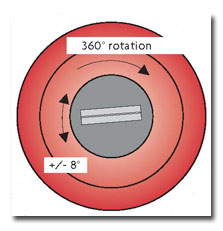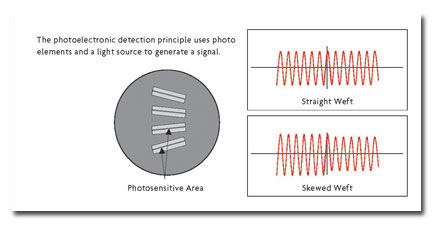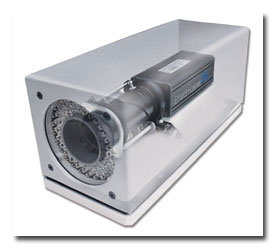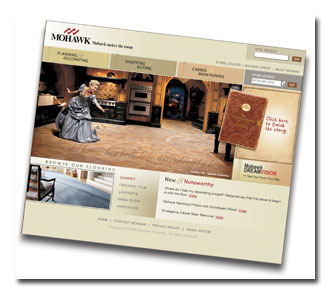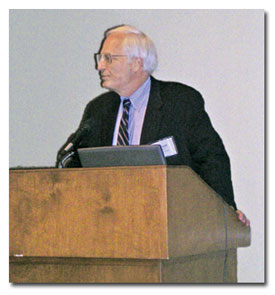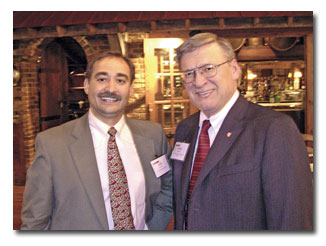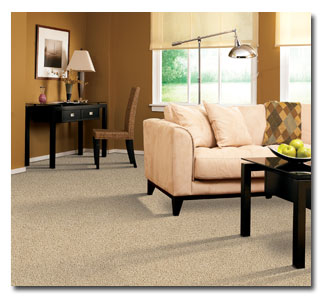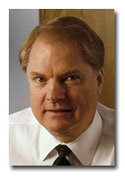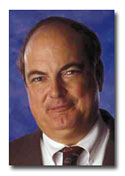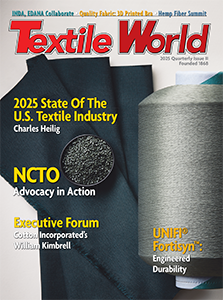A
s the 109th Congress winds down between now and November, the US textile industry and
importers have a vital stake in some of the issues that may or may not be dealt with in an
atmosphere charged with politics as the congressional election campaign unfolds. For the most part,
textile issues are in the area of international trade, where decisions made now will have a major
impact on the future shape of the industry. In some cases, congressional action is expected this
year, while others likely will have to wait for the new Congress in 2007.
Berry Amendment — The Berry Amendment, which directs the Department of Defense
(DoD) to buy its textiles and apparel from domestic courses whenever possible, will be acted upon,
but there is an effort by Rep. Robin Hayes, R- N.C., to expand the requirement to the Department of
Homeland Security. Past efforts by DoD procurement officials to weaken the Berry Amendment have for
the most part failed, but those officials are likely to try again. Extension of Buy American to
homeland security remains doubtful at best.
Chinese Currency — US textile industry officials and others contend currency
manipulation by the Chinese government amounts to as much as a 40-percent subsidy for its exports
to the US market. A number of bills have been introduced in Congress to address the issue. One
sponsored by Sens. Charles Schumer, D-N.Y., and Lindsey Graham, R-S.C., would impose a 27.5-percent
tariff on Chinese goods imported to the United States unless the president certifies China no
longer is manipulating its currency in order to gain an unfair international trade advantage. A
companion measure in the House of Representatives is sponsored by Reps. Sue Myrick, R-N.C., and
John Spratt, D-S.C. Those bills are not likely to become law in view of President George W. Bush’s
opposition, but they have been useful as a club to force voluntary action by the Chinese
government. A second approach to the problem, sponsored by Reps. Tim Ryan, D-Ohio, and Duncan
Hunter, R-Calif., would declare exchange rate manipulation by China actionable under US
countervailing duty and product safeguard statutes. That bill has the backing of a broadly based
farm, industry and labor currency manipulation coalition including textiles; and has a better
chance of enactment than the Schumer-Graham bill.
Trade Preference For Least-Developed Countries — The Tariff Relief Assistance for
Developing Economies (TRADE) Act would permit 15 least-developed countries to ship their textile
apparel products to the United States duty-free regardless of the country of origin of yarn, fabric
or other components. US textile manufacturers are opposed to this legislation, contending it would
undercut the benefits of the North America Free Trade Agreement and the Central America-Dominican
Republic Free Trade Agreement. This legislation enjoys considerable support and could be enacted,
but not without a fight from the textile industry’s supporters in Congress.
Countervailing Duties For State Economies — A major problem for US textile
manufacturers is a ruling by the government that countervailing duties cannot be imposed on
state-run economies such as China and Vietnam. The House in July 2005 passed legislation designed
to reverse that ruling. In addition, it would establish a monitoring and reporting system to
measure China’s compliance with its trade obligations under the World Trade Organization (WTO).
Senate action is pending.
Free Trade Agreements — Congressional action is pending on free trade agreements
(FTAs) that the US textile industry opposes. The Haiti Economic Recovery Opportunity (HERO) Act
would grant duty-free entry into the United States for apparel assembled in Haiti regardless of the
fabric’s country of origin. The HERO bill caps the amount of duty-free articles that can enter the
United States, and while the numbers appear small, they would amount to $2 billion in apparel
exports taken from other Caribbean and Central American countries. The Bush administration also has
entered into FTA negotiations with South Korea. While that pact has not been finalized and sent to
Congress, the US textile industry is strongly opposed to it, and it hopes to get congressional
input that will modify it before it is submitted for ratification.
Vietnam Agreement — Legislation that would grant permanent normal trade relations
to Vietnam has been introduced in Congress. The legislation is a necessary step toward Vietnam’s
accession to the WTO. It is strongly opposed by US textile manufacturers, but importers are
supporting it.
Textile And Apparel Research Funding — Legislation pending in Congress would
continue the federal government’s long-standing support for textile and apparel research at the
Spring House, Pa.-based National Textile Center (NTC) and the Cary, N.C.-based Textile Clothing
Technology Corp. [(TC)2] at the current levels of $13 million for NTC and $2.5 million for (TC)2.
The federal government’s support for these two organizations is intended to improve the industry’s
competitiveness. With Congress tightening its purse strings in some areas, the outlook is uncertain
at this time.
Textile Trade Future Cloudy In View Of WTO Problems
The uncertain future of the WTO’s Doha Round of trade liberalization negotiations raises more
questions than answers with respect to the future of international trade in textiles and apparel.
While trade officials in the United States and abroad hope the round can be revived, there is a
chance it will die a slow death over the next few months.
The demise of the negotiations would be one of those good news/bad news situations for
textile manufacturers and importers. If the talks collapse, the US industry would not have to worry
about reductions or elimination of US textile and apparel tariffs. On the other hand, they feel the
round can be a vehicle to get a permanent safeguard mechanism that would prevent China, and perhaps
one or two more nations, from completely dominating the US apparel import market. Importers, on the
other hand, who do not like the idea of a safeguard mechanism, would lose the tariff reductions
they believe are so important in their future overseas sourcing.
As the talks reached a critical juncture in early July, the House weighed in on behalf of the
US textile industry when it passed legislation stating the US negotiators must adhere to the
objectives of the Trade Act of 2002. That act states: “The principal negotiating objectives of the
United States with respect to trade in textile and apparel articles are to obtain competitive
opportunities for the [US] exports of textiles and apparel in foreign markets substantially
equivalent to the competitive opportunities afforded [to] foreign exports in the [US] markets and
to achieve fairer and more open conditions of trade in textiles and apparel.”
While that language is somewhat vague and can be read in different ways by different people,
it does underscore the congressional interest in promoting fair trade in textiles.
Military Procurement Of Textiles, Apparel Faces Crisis
While the US textile and apparel industries have a long history of successfully meeting the
peacetime and wartime needs of the armed forces, demands of the war on terrorism and military
procurement practices are resulting in what many industry officials believe is a crisis. They
contend the defense industrial base is eroding to the point where it is increasingly difficult for
them to meet the needs of the armed forces.
The problem has resulted from inconsistent buying patterns. New orders are few and far
between, incoming orders under existing contracts are sporadic and unpredictable, and frequent
start/stop orders are being issued. In past wartime buildups, the military relied on more of a
centralized procurement system, but today procurement is spread across several agencies with
differing requirements and procedures. Industry officials say the Iraq War and lack of
communication and organization have caused “tremendous confusion in the industry, stretched limited
resources to the breaking point and have made fact-based production planning nearly impossible.”
The National Textile Association, Boston; the American Apparel and Footwear Association,
Fairfax, Va.; and the Parachute Industry Association, Skokie, Ill. — which represent most of the
500 companies of the defense industrial base — have launched a series of meetings with defense
officials in an effort to fix the problem.
Members of the defense industrial base provide the armed forces with their most basic needs:
socks, undergarments, combat and other uniforms, hats, gloves, boots, wet-weather gear,
cold-weather gear, chemical-protective gear, body armor, utility bags, sleeping systems, parachutes
and tents.
July/August 2006

